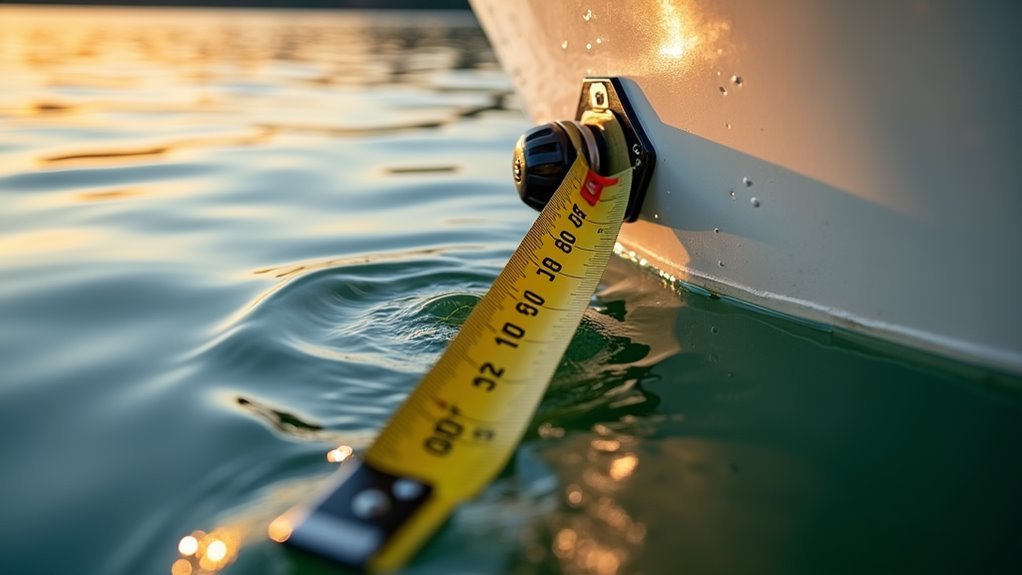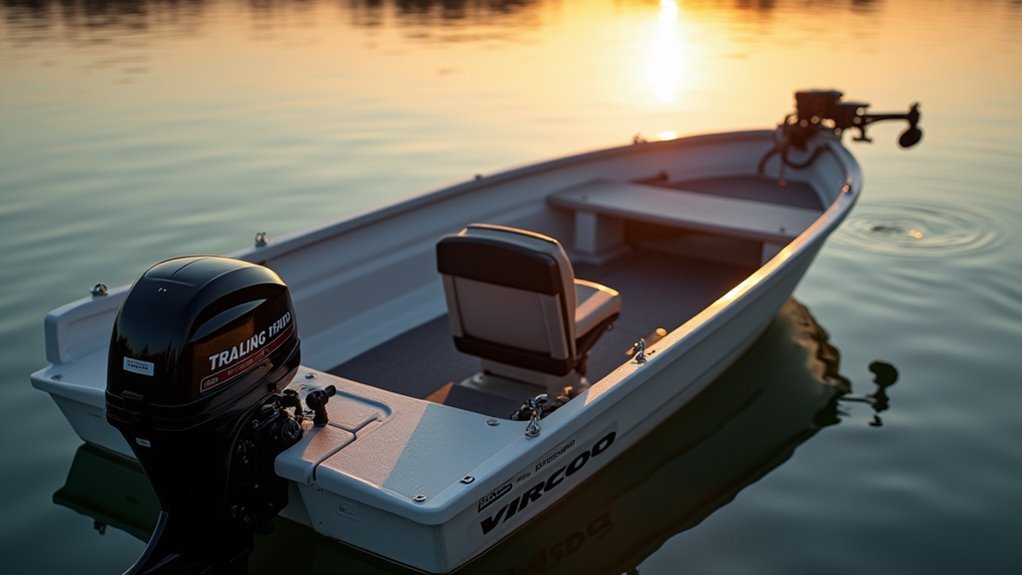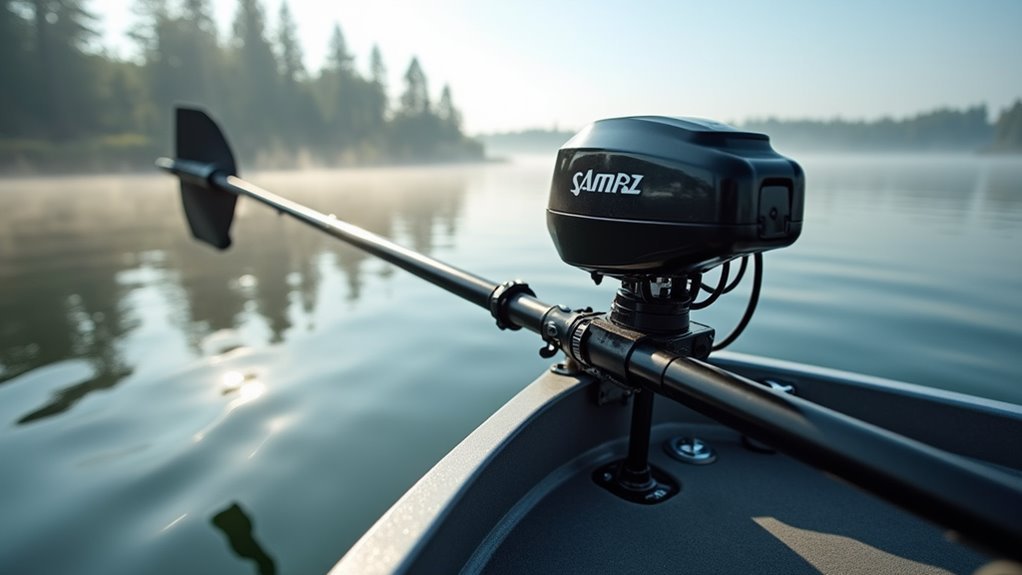Many boat enthusiasts don't realize that an incorrectly sized trolling motor can reduce their fishing success by up to 40% through poor boat control and fish-spooking noise. We'll help you avoid these common pitfalls by showing you how to select the perfect trolling motor length for your vessel. While the basic calculation starts with measuring from your mounting surface to the waterline, there's much more to take into account, including water conditions, mounting style, and standing height requirements. Let's explore how these factors work together to guarantee you get the best performance from your trolling motor investment.
Measuring Your Boat's Requirements
Finding the right trolling motor shaft length starts with careful measurement of your boat's dimensions.
Let's get your waterline measurement for fishing by measuring from your boat's mounting surface down to the water. For a proper shaft length, we'll add 22 inches in freshwater or 25 inches in saltwater to guarantee peak performance.
If you're heading into choppy waters, we'll want to add 5 to 30 more inches depending on your boat's size.
For those of you using bow-mount hand controls, don't forget to add 9 inches, plus another 12 if you'll be standing while steering.
Before finalizing your TROLLING MOTOR SELECTION, we recommend checking the manufacturer's specs to confirm your shaft length selection matches your MOTOR needs.
Types of Motor Mounting
When selecting a trolling motor, you'll need to decide between two primary mounting configurations: bow mount and transom mount.
Let's explore how each type affects your shaft length requirements and overall boating experience.
Bow mount trolling motors, which we install at the front of your boat, typically need longer shafts to keep the propeller underwater, especially when you're cutting through choppy waters.
We recommend adding 9 inches to your water line measurement for these installations.
In contrast, transom mount motors, which attach to the back of your boat, generally have more straightforward shaft length requirements.
Whichever style you choose, we'll need to carefully measure from the mounting surface to the water line to guarantee your motor performs at its best and avoids frustrating cavitation issues.
Waterline Distance Calculations

To guarantee your trolling motor performs at its finest, accurate waterline distance calculations are essential for proper shaft length selection.
We'll start by measuring from your boat's bow to the waterline, then add 22 inches for freshwater fishing conditions or 25 inches for saltwater. If you're planning to tackle rough waters, we'll need to add 5 to 30 more inches depending on your boat size.
For those choosing a bow-mount hand control motor, let's factor in an extra 9 inches to guarantee comfortable steering while standing.
Remember, we want the propeller submerged at least 12 inches below the waterline for maximum submersion and performance.
While it might be tempting to cut corners, going with a slightly longer trolling motor shaft length is better than too short – you can't adjust it once it's mounted!
Weather and Water Conditions
Since weather and water conditions greatly influence trolling motor performance, selecting the right shaft length requires careful evaluation of your local boating environment.
Shaft length is important when we're dealing with rough water conditions, where we'll need to add 5 to 30 extra inches to our waterline measurement.
In windy situations, we want to prevent cavitation by keeping the propeller well submerged, ensuring ideal performance with at least 12 inches below the waterline.
If we're boating in saltwater, we'll need to factor in an additional 25 to 40 inches due to wave action.
Strong currents can also affect how our boat sits in the water, so we'll want to take these factors into account when taking our initial waterline measurement.
Bow Mount Vs Transom Mount

The choice between bow and transom mount trolling motors greatly impacts the shaft length we'll need. Bow mounts typically require longer shafts, often needing an extra 20-30 inches for ideal performance. When we're dealing with rough water, we'll want to add even more length to keep our motor running smoothly.
| Feature | Bow Mount | Transom Mount |
|---|---|---|
| Basic Length | Longer shaft | Standard shaft |
| Standing Operation | +12 inches | Not applicable |
| Hand Control | +9 inches | Not applicable |
| Rough Water | +27-30 inches | Similar adjustment |
| Installation Height | More variable | More consistent |
Let's remember that proper shaft length prevents cavitation, which can really hurt our motor's performance. While transom mounts are more forgiving, we'll still need to measure carefully to keep the propeller properly submerged.
Proper Propeller Depth Setup
Having selected the right mount type for our boat, we now need to focus on getting the propeller depth just right. To achieve ideal performance, we'll want our propeller submerged at least 12 inches below the waterline to prevent troublesome cavitation.
Let's measure from the mounting surface to the water's edge – this is essential for both freshwater and saltwater setups. For freshwater, we'll need the bow-to-waterline distance plus 22 inches, while saltwater requires an extra 3 inches.
Don't forget about those rough water conditions – we'll want to add at least 5 inches for general use. If you're heading offshore, you might need up to 30-40 inches of additional shaft length.
Power and Performance Considerations

While getting the shaft length right is crucial, proper power and performance depend on several key factors working together. Let's look at what it takes to get your trolling motor operating at its best mode. The relationship between length, thrust, and boat weight directly impacts your boating freedom.
| Factor | Impact |
|---|---|
| Shaft Length | Controls propeller depth |
| Water Type | Determines minimum length |
| Boat Weight | Affects bow rise |
| Wave Action | Influences performance |
| Operating Mode | Sets thrust efficiency |
We've found that adding extra length to the minimum requirement helps guarantee better performance, especially in choppy conditions. By keeping your propeller submerged at least 12 inches, you'll maintain consistent thrust and avoid the power-robbing effects of cavitation, giving you the control you need on the water.
Frequently Asked Questions
How to Choose the Length of a Trolling Motor?
Let's measure from mount to waterline, adding 12 inches for proper submersion. We'll consider our boat's weight, power needs, and water conditions when selecting shaft length for ideal motor performance.
How Big of a Boat Will a 55LB Trolling Motor Push?
We'll get ideal performance from a 55lb trolling motor on boats up to 2,750 pounds. While it'll push larger boats, you'll want extra thrust power if your boat weight and size exceed these capacity limits.
Can a Trolling Motor Be Too Long?
Yes, we've found trolling motors can be too long, affecting boat stability and maneuverability. Excessive motor shaft length creates unwanted drag, reducing performance efficiency and making your boating experience less enjoyable.
How Do You Measure Your Boat for Trolling Motor?
Ready to measure like a pro? Let's measure from our mounting location to the waterline, considering trolling motor types and shaft depth needed. Don't forget motor weight and battery capacity for peak performance.